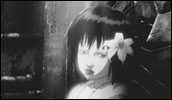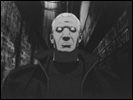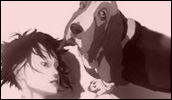Innocence
- Year
- 2004
- Original title
- Inosensu
- Japanese title
- イノセンス
- Alternative title
- Ghost in the Shell 2: Innocence
- Director
- Cast
- Running time
- 99 minutes
- Published
- 15 April 2004



by Jasper Sharp
A couple of weeks before the release of Mamoru Oshii's eagerly awaited follow-up to Ghost in the Shell, the cult cyberpunk anime that proved such a key influence on the Matrix films, an exhibition entitled Dolls of Innocence opened at the Museum of Contemporary Art in Tokyo. It showcased a number of works whose influence is heavily saturated within this second movie, including the twisted, disproportionate foetal forms of Hiroko Igeta, the grotesque ensemble of transmogrified bodyparts stitched together ad hoc by Etsuko Miura and the most crucial impetus according to Oshii, the heavily eroticised doll sculptures of German surrealist Hans Bellmer (1902-1975).
Walking around the Dolls of Innocence exhibition was a singularly disquieting experience. Looking about quickly, the forms of the museum visitors seemed to mingle indistinguishably with those of the figures they'd come to see. A closer glance revealed the crucial differences: gaping body cavities held bounded by wooden rib cages, limbs grafted onto torsos by crude epoxy ball and socket arrangements, and in many cases missing altogether. Whilst the figures looked lifelike, such lacunae highlighted the obvious: they were clearly not alive. Yet as their glassy eyes glared from frozen, expressionless masks at the visitors from every corner of the gallery, there remained the air of something conscious, something knowing about their presence. This is the essence of Oshii's new film: that whilst what marks us out as human is clearly tangible, it remains as impossible to pinpoint or quantify as such abstract notions as "innocence".
Much could be made of Japan's doll obsession. From its traditional roots in celebrations such as that of the Hina Matsuri (or Girl's Day) every March when families take out their ornamental figures to ensure the happiness and well-being of their daughters, to everyone's favourite synthesised pet, the robotic dog created by Sony known as the AIBO, the nation seems driven with this urge to reconstruct the real without having to deal with the messy parts. Who was it that pointed out that the geisha represented the ultimate desire to reduce a woman's role to that of a purely functional "living doll"? I even heard recently that someone had managed to build a life-size robotic female whose chest heaved up and down to emulate her breathing. It would seem that Oshii's vision of the future isn't so far off after all.
Innocence features a lot of dolls, and their usage within the format of an animated film raises a host of interesting questions as to the numerous levels of distinction that can be made between the authentic and the simulated. Strictly speaking, a doll's purpose is the representation of the human form. For all their strivings for realism, dolls are an abstraction in the same way that animation is an abstraction of live action cinema (which in turn is an abstraction of the real thing, reality, a theme Oshii explored in his previous anti-animation Avalon). In both, there remains the question of balance between the realistic representation of the object and the removal of those niggling, redundant details. What is stripped out, the mind of the individual human observer fills in.
Though the use of the Japanese word "ningyo" for both blurs the distinction, it is worth reflecting over a crucial difference between dolls and puppets, especially given that the first Ghost in the Shell made heavy use of a character called "The Puppet Master". The goal of puppetry, like animation, is to emulate what we understand as human emotions through speech and movement. An alternate word for the puppeteer, "animateur", spells out the similarities between the two. The very word "animation" means giving psychic qualities - an "anima", or a soul - to an inanimate object. The object need not be realistic looking. In Western puppet theatre we know that the puppet is always the extension of the puppeteer, without which all is left is a useless bundle of cloth, strings and wood. Whilst we are presented with the illusion of an object with a soul, it is clearly presented as an illusion, and so we swallow it wholeheartedly.
In Empire of Signs, Roland Barthes explores this dichotomy between the animate and inanimate within the bunraku theatre (as showcased at the beginning of Kitano's Dolls), which might be best described in terms of a puppet theatre that uses dolls. In Bunraku each figure is manipulated by three clearly visible operators, dressed in black, and all of the voices emanate from a "gidayu" chanter, disembodied from the puppets in a position physically located away from the stage. Its characters look human, and they move like humans. However, the doll drama presents us with neither an attempt at realism nor simulation, but a spectacle distinct from both of these. "Bunraku does not aim at 'animating' an inanimate object so as to make a piece of the body, a scrap of a man, 'alive', while retaining its vocation as a 'part'; it is not the simulation of the body that it seeks but, so to speak, its sensuous abstraction," as Barthes says. As the illusion of a body animated by a single mind evaporates with the control of its form, speech, and movement separated into three distinct modules, we are forced to reassess what we actually mean by giving an inanimate object an "anima".
From the haunting stop-motion animation of Kihachiro Kawamoto to recent attempts at live-action simulation via CGI à la Malice@Doll, the marriage of dolls with the world of animation has often played on these feelings of the eerie and the uncanny brought about by the paradox of striving to reconcile this discrepancy between psychological and physical "realism". Oshii's new film uses this idea as its central axis. What is human, and what is real, it asks us, and are the two questions the same thing?
Set in 2032, the new film continues a few years after the events of the original Ghost in the Shell but remains within its automated setting, a world where humans and cyborgs (varying degrees of part-man and part-machine) co-exist side by side. In this future the dividing area between mechanism and organism is a murky one. Submarines prowl like sharks through crimson-tinged waters and sleek airborne vehicles glide by twilight like tattered crows across a cityscape of lofty gothic spires.
Carried on from the first film is the character of Bateau, a special agent for Security Police Section 9. With his ashen complexion, snowy-white ponytail and eyes like jeweller's lenses, though humanoid, as far as his physical make-up goes he is all but human. Completely mechanised, his mind has nevertheless assimilated the disembodied consciousness of his former partner and heroine of the first film, Motoko Kusanagi, something that lends him a small but vital pang of humanity. His current partner, the mullet-headed Togusa, is his complete antithesis, wholly organic but with a synthetic brain, he is nonetheless the closest to human on the entire Section 9 team.
In its early stages, Innocence sets out as a police procedural, but soon becomes involved in loftier concerns. A wave of homicides is striking at members from the higher echelons of the city's powerful political and financial elite, as completely mechanised "gynoid" service dolls begin turning on their masters before dramatically self-demolishing. Bateau and Togusa are called in by Department Chief Aramaki to investigate. In the opening scenes Bateau corners an exotically dressed child service doll skulking at end of a dark alley in the heart of Chinatown. Whimpering "Help me…", she claws off the prosthetic skin on her chest before erupting in an explosion of springs and cogs. What is the cause of this spate of murders? Aramaki suspects terrorists, but is the death of a wholly synthetic automaton any less significant than that of a cyborg with some vestiges of human parts left over?
The original Ghost in the Shell presented us with a vision of the future city as a self-regulating life form, maintaining its existence through mechanised means such as electronic transactions whilst continuing to evolve into new forms. Its human components were to all intents and purposes entirely redundant. And then the system began to evolve its own consciousness and with it, a capricious self-destructive urge. Innocence continues in its exploration of this territory, asking what happens if such technology extends not only to the environment but to the individual within it in its search for this ultimate in order and control.
Fitting for a film about self-referentiality and rebirth, the credit sequence of Innocence echoes that of its predecessor closely. This "cyborg birth scene" is perhaps one of the most singularly impressive openings to register on the big screen in a long, long time. In the dark amniotic waters, a single cell begins dividing recursively before mutating into a collection of individual biomorphic sections. These form into jointed limbs and a segmented spinal column connected by snaking cable-like sinews, the strands of which twist like a DNA double helix to bind the individual parts as they transform into the flat planar forms making up the sections of what slowly comes to resemble a clothes shop mannequin.
Bundled into the aesthetic concerns of Innocence is Oshii's ongoing thematic one, that science is also merely an abstraction of human thought. Taken to its extremes, technology has the ability to perfectly replicate both the functions and surface details of the real world, as well as those of its own. But in a world where disciplines such as genetics and economics blur the distinctions between master and servant, these developments in human knowledge have taken us further away from our natural environment, cutting out everything that has no immediately apparent purpose. Does anything not in a form that can be recognised or represented by a computer cease to have any meaning, and can the realms of spirituality or morality also be confined within the logic of the algorithm? Each syllogistic step followed along this road of so-called human progress takes us further away from the conditions of our genesis, a state which is best defined as unknowing, or "innocence". Or to coin the movie's tagline, "Innocence is Life".
Ironically intended or not, in its evocation of a world in which the division between the genuine and the artificial is not so easily discerned, Ridley Scott's Blade Runner casts the most obvious shadows. Like that film, Innocence's topography springs fully formed from a grab-bag of stylistic influences drawn from different eras and different sources across the world. Similar to the way that the melody of Joaquín Rodrigo's Concierto de Aranjuez (which was also adopted for Mario Bava's atmospheric supernatural horror Lisa and the Devil in the 1970s and more recently formed the basis of Tara Fitzgerald's eye-watering flugel solo in Mark Herman's Brassed Off) works its way into the bluesy ballad, Follow Me, that closes the film, the movie's ersatz locations too parade as nothing more than replications, elements divorced from their original circumstances; the sleek retro designs of the cars that drive through the futuristic streets; the gaudily exotic Chinatown parade dominated by the statue of a towering ornate elephant; the musty Victoriana of the mansion where the skeletal presence of former ghost-hacker Kim (voiced by the ubiquitous Naoto Takenaka) hides out, lounging in an armchair wrapped in a red smoking jacket. Bateau and Togusa's investigation leads from sterile laboratories kitted out with doll parts, their synthetic skin held apart in a flaps by clamps and surgical wire, through old dark mansions straight from the pages of Agatha Christie, whose musty libraries have their walls racked with leather bound books, and whose sinks overflow with blood-stained murder implements. The script even cross-references Oshii's previous work: a scene with Bateau returning to an apartment of empty beer cans and coffee mugs to feed his basset hound is sure to bring smiles of recognition.
Certainly 2004 is going to go down in history as a landmark year for animation, with Innocence first out of the gates amongst the year's other major offerings Appleseed, Steamboy, and Howl's Moving Castle. Now that there seems to be more attention than ever focused on the field, Oshii's latest may well find itself to be a large number of people's first experience of Japan's most celebrated contribution to the world of cinema, something that seems even more assured given that, in the first case of its kind, its distribution rights were bought by Dreamworks in the United States even as the film was being put together. The US release follows some six months after the domestic one.
Only the most argumentative of sorts would claim that Innocence isn't absolutely stunning, boasting such dazzlingly evocative sequences as an eerie doll-burning ritual, a hypnotically staged ambush in a convenience store, the relentless momentum of the gynoid attack and some positively Dali-esque visions in the final quarter. We are looking at a technological leap akin to the one between Terminator and Terminator 2 here. With some reservation I would add though that, as with his previous films, it is perhaps not one of the most accessible entry points the genre has to offer. It provides none of the grand narratives of similarly-themed works like The Terminator or The Matrix, and when the climax hits, you are barely aware that it is a climax given the barrage that has gone before. If you weren't stirred by Avalon or the first Ghost in the Shell film, chances are you won't be too taken with this one either.
Oshii gives us more than enough material to inspire epic free associational flights for those with enough imagination to cope with it, but the onus is definitely up to the viewer to make their own connections. Whether the whole adds up to the sum of its aesthetic or intellectual components is something to be seen on further viewings - and believe me, Oshii's vision is too much to catch in one sitting. For now at least, these elements are certainly impressive enough for this viewer to want to go back for more.